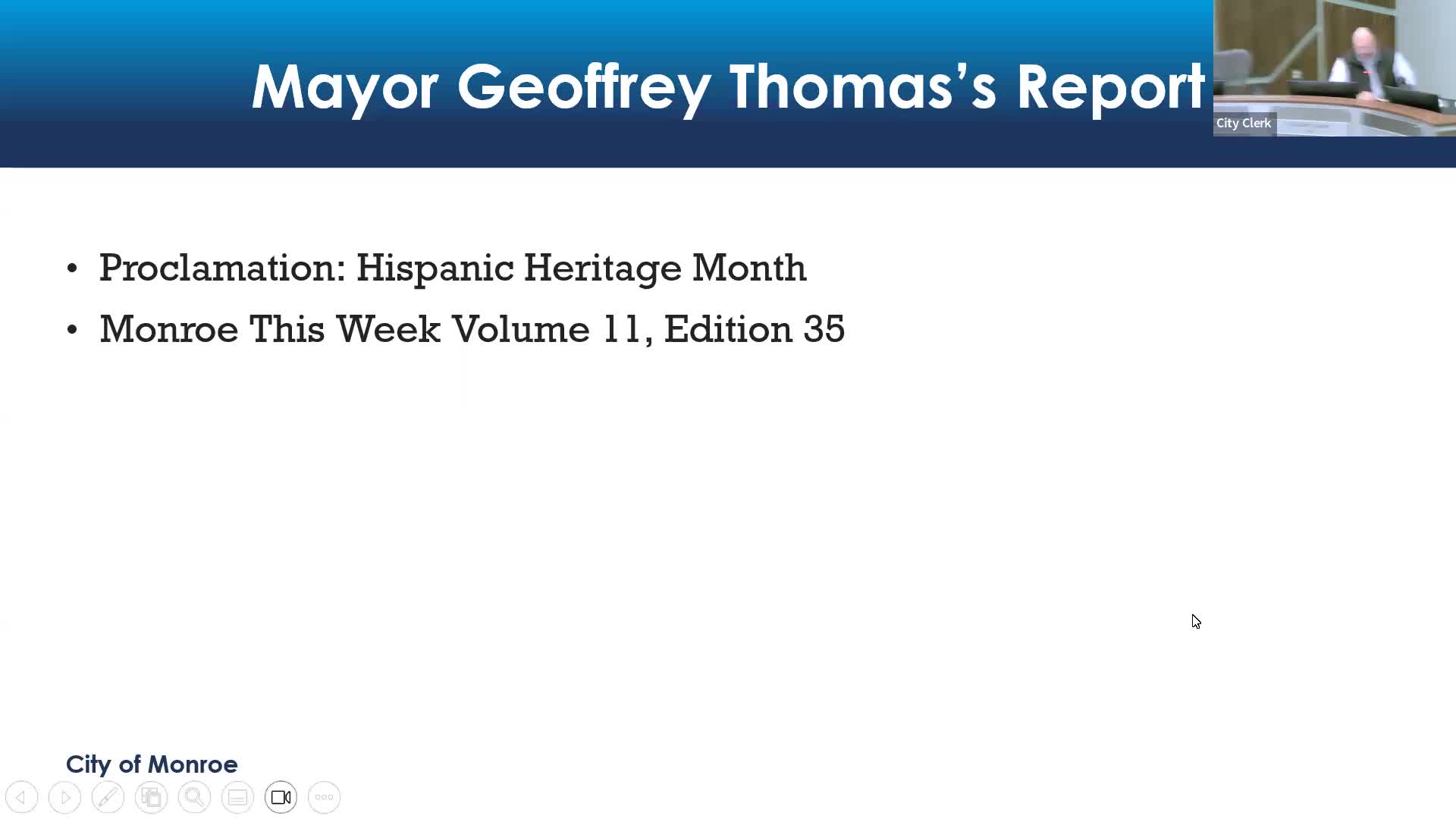Council directs festival‑lot plan toward Option 3 after public outreach; parks board to advise on design and funding
September 24, 2025 | Monroe City, Snohomish County, Washington
This article was created by AI summarizing key points discussed. AI makes mistakes, so for full details and context, please refer to the video of the full meeting. Please report any errors so we can fix them. Report an error »

Monroe’s consultants and staff presented results of a public engagement process for a proposed downtown ‘‘festival lot’’ on Sept. 16, and the council directed staff to advance the mid‑range concept (Option 3) to the parks advisory board for further design, prioritization and funding recommendations.
Patrick Doherty, a downtown‑planning contractor, described four illustrative concepts developed after council direction: a minimal renovation that retains the former bank building (Option 1), a modest plaza with some permanent event space (Option 2), a scraped‑site town plaza with a right‑sized building and the most public parking (Option 3), and a full town‑square treatment with more extensive public amenities (Option 4). The consultant presented preliminary, order‑of‑magnitude cost ranges: roughly $850,000–$1,000,000 for the least‑involved options, about $1.7–$1.9 million for Option 3, and about $2.3 million for Option 4.
The public engagement included two open houses and two farmers‑market booths; staff said the online survey received 365 responses. Respondents ranked Option 3 highest overall, citing a balance of open space, infrastructure and parking. Consultants said the survey showed high interest in a year‑round, flexible downtown space with shaded areas, public restrooms and programming such as markets, food‑truck nights and live music.
‘‘Option 3 balances open space with modest infrastructure and provides the most public parking,’’ Doherty said in summarizing the outreach. Council members repeatedly emphasized activation and maintenance: several asked that the site be programmed year‑round and that designs consider low maintenance, durability and compatibility with Main Street’s historic character.
Council members discussed near‑term uses while the city pursues design and funding. Several urged temporary activation of the site and signage announcing the festival lot to build community interest. Council member Beaumont suggested donor recognition features such as engraved bricks and outlined interest in fundraising and sponsorships. Council member Hanford recommended small, low‑cost improvements now to make the site presentable and usable for events while planning continues.
Council member Walker moved—then the council reached consensus without a formal recorded roll‑call motion—to advance Option 3 and forward the concept to the parks advisory board with council comments and direction to consider a splash pad and fundraising approaches and to recommend where the project would fit in the parks capital‑improvement plan. Mayor and council members voiced support across the dais; no formal vote was required because the council agreed on the course and staff will carry the referral forward.
Staff and consultants emphasized that the presented budgets were preliminary conceptual estimates for comparison only and would be refined if the council chooses to proceed to design and procurement. The council asked staff to return with a plan for near‑term site use and to put the festival‑lot timeline and next steps on the extended agenda for future meetings.
Patrick Doherty, a downtown‑planning contractor, described four illustrative concepts developed after council direction: a minimal renovation that retains the former bank building (Option 1), a modest plaza with some permanent event space (Option 2), a scraped‑site town plaza with a right‑sized building and the most public parking (Option 3), and a full town‑square treatment with more extensive public amenities (Option 4). The consultant presented preliminary, order‑of‑magnitude cost ranges: roughly $850,000–$1,000,000 for the least‑involved options, about $1.7–$1.9 million for Option 3, and about $2.3 million for Option 4.
The public engagement included two open houses and two farmers‑market booths; staff said the online survey received 365 responses. Respondents ranked Option 3 highest overall, citing a balance of open space, infrastructure and parking. Consultants said the survey showed high interest in a year‑round, flexible downtown space with shaded areas, public restrooms and programming such as markets, food‑truck nights and live music.
‘‘Option 3 balances open space with modest infrastructure and provides the most public parking,’’ Doherty said in summarizing the outreach. Council members repeatedly emphasized activation and maintenance: several asked that the site be programmed year‑round and that designs consider low maintenance, durability and compatibility with Main Street’s historic character.
Council members discussed near‑term uses while the city pursues design and funding. Several urged temporary activation of the site and signage announcing the festival lot to build community interest. Council member Beaumont suggested donor recognition features such as engraved bricks and outlined interest in fundraising and sponsorships. Council member Hanford recommended small, low‑cost improvements now to make the site presentable and usable for events while planning continues.
Council member Walker moved—then the council reached consensus without a formal recorded roll‑call motion—to advance Option 3 and forward the concept to the parks advisory board with council comments and direction to consider a splash pad and fundraising approaches and to recommend where the project would fit in the parks capital‑improvement plan. Mayor and council members voiced support across the dais; no formal vote was required because the council agreed on the course and staff will carry the referral forward.
Staff and consultants emphasized that the presented budgets were preliminary conceptual estimates for comparison only and would be refined if the council chooses to proceed to design and procurement. The council asked staff to return with a plan for near‑term site use and to put the festival‑lot timeline and next steps on the extended agenda for future meetings.
View full meeting
This article is based on a recent meeting—watch the full video and explore the complete transcript for deeper insights into the discussion.
View full meeting
